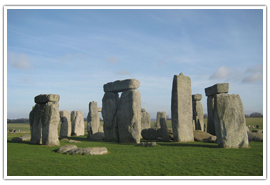Stonehenge England Facts: The mysterious prehistoric ruin, Stonehenge, is a one-of-a-kind monument that should not be missed. Located in the idyllic countryside of South-western England, just 8 miles north of the charming historic town of Salisbury, Stonehenge is easily accessible from London and makes for an intriguing and unique day trip. So if you are in London for a few days or even a few weeks and looking for something different to do, a short trek to Stonehenge is worth the effort.
Stonehenge England Facts
Stonehenge is composed of earthworks surrounding a circular setting of large standing stones. It is at the center of the densest complex of Neolithic and Bronze Age monuments in England, including several hundred burial mounds.
Stonehenge Theories
Archaeologists have believed that the iconic stone monument was erected around 2500 BC, as described in the chronology below. One recent theory, however, has suggested that the first stones were not erected until 2400-2200 BC, whilst another suggests that bluestones may have been erected at the site as early as 3000 BC (see phase 1 below).

The surrounding circular earth bank and ditch, which constitute the earliest phase of the monument, have been dated to about 3100 BC. The site and its surroundings were added to the UNESCO’s list of World Heritage Sites in 1986 in a co-listing with Avebury Henge monument. It is a national legally protected Scheduled Ancient Monument.
Stonehenge is owned by the Crown and managed by English Heritage, while the surrounding land is owned by the National Trust. The dating of cremated remains found on the site indicates burials from as early as 3000 BC when the initial ditch and bank were first dug. Burials continued at Stonehenge for at least another 500 years.
The distance from London to Stonehenge near Salisbury is about 150 km. There are a number of day operators working out of London that offers a day trip to Stonehenge.
Travel by Road
From Amesbury
2 miles west on the junction of A303 and A344/360
From London Gatwick Airport
Take the M23 motorway and join the M25 motorway, following the signs for Heathrow Airport. From the M25, exit at junction 12 for the M3 motorway towards Basingstoke. Once on the M3 follow it to junction 8 signed A303 Andover. Continue on the A303 ALL the way until you reach a roundabout. Go straight over this and 2 miles on bear right onto the A344 and the car park is on the right-hand side about 500 meters on.
From London Heathrow Airport
Follow signs to the M4 West. Continue for about 2 miles and come off at junction 4b onto the M25 Southbound. Follow the signs for Gatwick Airport. From the M25, exit at junction 12 for the M3 motorway towards Basingstoke. Then follow the directions as above.
Travel by Train
The nearest train station to Stonehenge is Salisbury about 9.5 miles away.
From London, the trains depart from Waterloo Station to Salisbury.
Check for times and prices as these may be subject to change and the trains depart approximately every hour. The journey takes about an hour and a half. Local buses or a cab can take you on.
Travel by Bus
The buses depart from Heathrow Airport and from Victoria Coach Station in the center of London. The journey takes about 2 hours. Get off at Amesbury. From there you can either walk (about 2 miles), catch a local bus, or get a taxi. You can buy tickets on the coach, at the coach station, or from ticket agents for National Express. It is the cheapest way to travel to Stonehenge. If you are coming from Gatwick Airport you will need to first get to Heathrow Airport or to Victoria coach station (you can do this by bus) and from there change buses to Amesbury.
Useful telephone numbers
British Rail’s Information line:
08457 48 49 50
www.thetrainline.com
National Express link
08705 80 80 80 (10p per min)www.nationalexpress.com
Local buses to Stonehenge
www.wdbus.co.uk/
Post Code-SP4 7DE
England Trains – Information on getting and reading your train ticket, the high speed, and regional train system; a link of train schedules.
More Info On- London Travel Guide, Salisbury Travel Guide, Wiltshire
